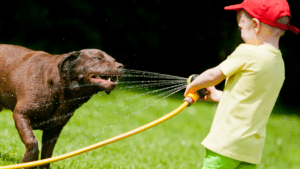
In a study released in April 2017, after reviewing 1616 consecutive pediatric dog bites treated at a single Level 1 trauma center in Atlanta, Georgia, it was found that 46 dog breeds were identified in 509 cases. Pit bulls inflicted the highest prevalence of injuries, 38.5% (196) and their bites were implicated in 50% of all surgeries performed. This breed is 2.5 times as likely to bite in multiple anatomic locations as compared to other breeds.
Another study at a Level 1 trauma center in Phoenix, AZ, showed that 282 pediatric patients who suffered dog bites were studied. Of the breeds identified in 213 cases, 75.5% were pit bulls. The report states, “Dog familiarity did not confer safety, and in this series, pit bulls were most frequently responsible. These findings have great relevance for child safety.”
Unlike all other breeds, pit bull terriers were relatively more likely to attack an unknown individual (+31%), and without provocation (+48%), according to a study of 334 dog bites at a Level 1 trauma center in Sacramento, CA. In fact, pit bulls followed by German shepherds, and mixed breeds consistently inflicted the highest causes of injury through this study at all locations.
While summer months should be carefree for children, more dog bites are reported to occur during this time than any other. The reason is because more people are outdoors, more dog owners have their pets outside and the likelihood of interaction increases. Research also suggests that dogs may be irritated by the warmer weather, allowing them to become agitated easily. With 27% of dog bite injuries being caused by family pets, and 64% being bitten in multiple locations, it is important for dog owners to be aware of the risks as well as their responsibilities.

Responsible dog owners should follow the recommendations made by the American Veterinary Medical Association on responsible dog ownership. Following these measures builds a solid foundation for dog bite prevention. Some basics of responsible dog ownership and dog bite prevention include the following:
- Carefully select your dog. Puppies should not be obtained on impulse.
- Make sure your pet is socialized as a young puppy so it feels at ease around people and other animals.
- Don’t put your dog in a position where it feels threatened or teased.
- Train your dog. The basic commands “sit,” “stay,” “no,” and “come” help dogs understand what is expected of them and can be incorporated into fun activities that build a bond of trust between pets and people.
- Walk and exercise your dog regularly to keep it healthy and provide mental stimulation.
- Avoid highly excitable games like wrestling or tug-of-war.
- Use a leash in public to ensure you are able to control your dog and to show others that you are in control of your dog.
- Keep your dog healthy. Have your dog vaccinated against rabies and preventable infectious diseases. Parasite control and veterinary care are also important because how your dog feels affects how it behaves.
- Neuter or spay your dog.
- If you have a fenced yard, make sure the gates and fence are secure.
While dogs can be unpredictable, there are ways to avoid being bitten according to the AVMA. Besides socialization and education, anyone around a dog should avoid risky situations, not interact with dogs and avoid petting in these scenarios:
- If the dog is not with its owner
- If the dog is with its owner but the owner does not give permission to pet the dog
- If the dog is on the other side of a fence—don’t reach through or over a fence to pet a dog
- If a dog is sleeping or eating
- If a dog is sick or injured
- If a dog is resting with her puppies or seems very protective of her puppies and anxious about your presence
- If a dog is playing with a toy
- If a dog is growling or barking
- If a dog appears to be hiding or seeking time alone
What should you do if bitten by a dog or your dog bites someone else? Follow these steps and then call Friedman & Martin at 912-232-8500. We are experts in dog bite cases and can help determine your best course of legal action. Not all bites result in legal action being taken, and we can help determine your legal rights after a dog bite. www.savinjurylaw.com
